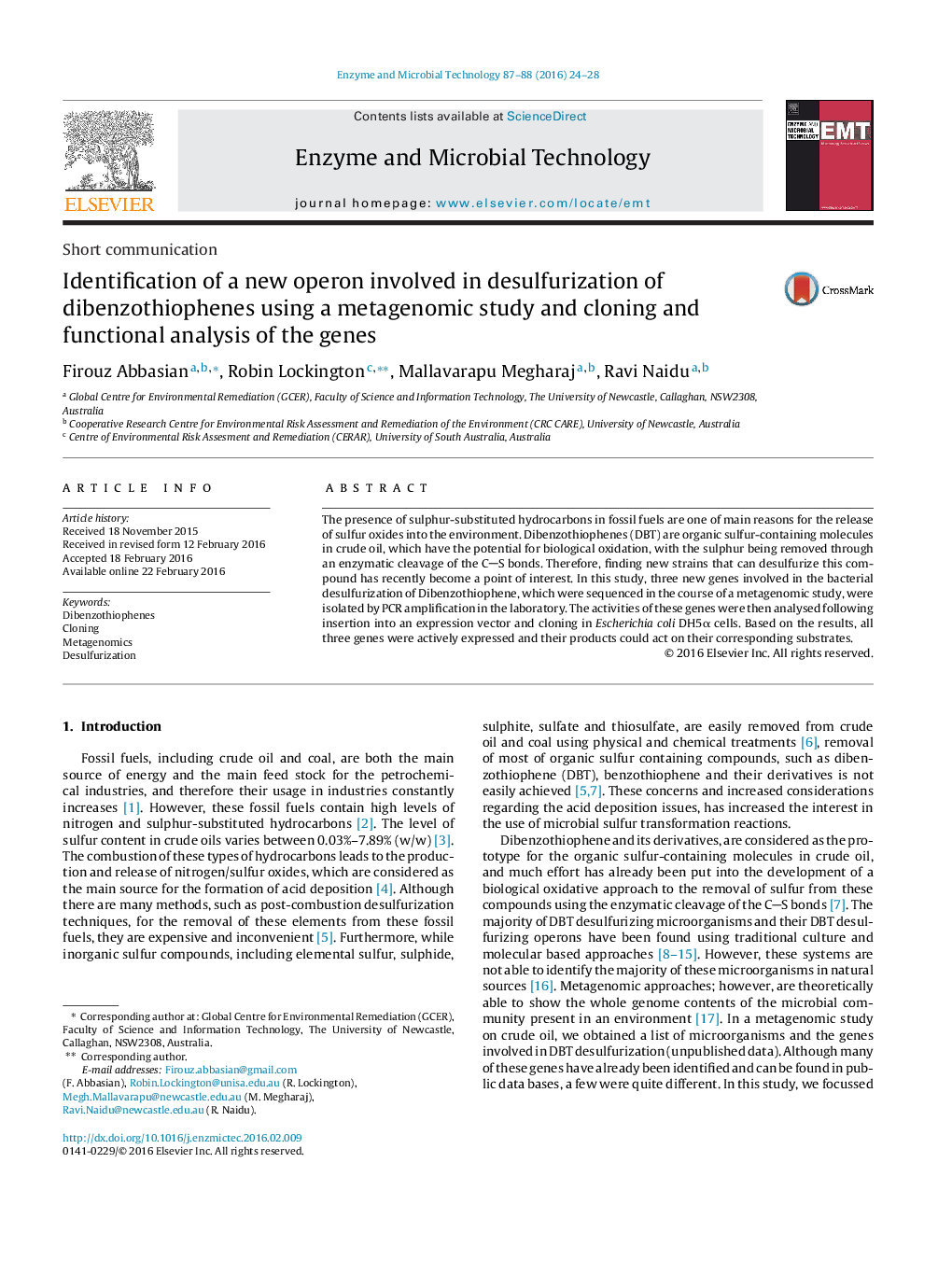| کد مقاله | کد نشریه | سال انتشار | مقاله انگلیسی | نسخه تمام متن |
|---|---|---|---|---|
| 16808 | 42614 | 2016 | 5 صفحه PDF | دانلود رایگان |
کلمات کلیدی
1.مقدمه
۲. مواد و روشها
۱.۲. توالی ژن و طراحی پرایمر
۲.۲. کلونینگ ژن و آزمون آنزیم
جدول ۱. لیست پرایمرهای طراحی شده برای تقویت اپرون جدید گوگردزدایی دیبنزوتیوفن
۳.۲. عدد موقعیت
۳. نتایج و بحث
شکل ۱: مسیر گوگردزدایی دیبنزوتیوفن در Gordonia sp.؛ dszA: دیبنزوتیوفنسولفون (DBTO2) مونواکسیژناز، dszB: ۲-(۲-هیدروکسیفنیل)-بنزنسولفونات (HBPS)، dszC: دیبنزنتیوفن مونواکسیداز و dszD: NAD(P)H:FMN اکسیدردوپکتاز، DBT: دی بنزن تیوفن، DBTO: دی بنزن تیوفن سولفوکسید، DBTO2: دی بنزن تیوفن سولفون، HBPS: ۲-(۲-هیدروکسیفنیل)-بنزنسولفونات، HBP: ۲-هیدروکسیفنیل.
شکل ۲. طول و جهت ژنهای درگیر در مسیر گوگردزدایی دیبنزنتیوفن یافتهشده در این مطالعه، و گپها و همپوشانیهای این سه ژن. این سه ژن (dszA, dszB and dszC) به ترتیب مشابهتهایی برابر با ۷۸٪، ۷۳٪ و ۷۷٪ با ژنهای مشابه در مقایسه با ژنهای ثبتشده در NCBI نشان دادند.
شکل ۳. نمودارهای طیفسنجی فعالیت آنزیم بر اساس مقادیر اکسیداسیون NADH در طول زمان. در حالی که مقادیر اکسیداسیون NADH در گونههای نوترکیب dszC و dszA (B و D در شکل) به غلظتهایی نزدیک به صفر افت کردند، این مقادیر در گونههای غیرنوترکیب متناظر (A و C در شکل) تغییری نداشتند.
• Metagenomic study on crude oil.
• Mining a unique dibenzothiophene desulfurization gene.
• Extension of this gene by softwares to find whole operon.
• PCR amplification and coning of these genes.
• Expression analysis.
The presence of sulphur-substituted hydrocarbons in fossil fuels are one of main reasons for the release of sulfur oxides into the environment. Dibenzothiophenes (DBT) are organic sulfur-containing molecules in crude oil, which have the potential for biological oxidation, with the sulphur being removed through an enzymatic cleavage of the CS bonds. Therefore, finding new strains that can desulfurize this compound has recently become a point of interest. In this study, three new genes involved in the bacterial desulfurization of Dibenzothiophene, which were sequenced in the course of a metagenomic study, were isolated by PCR amplification in the laboratory. The activities of these genes were then analysed following insertion into an expression vector and cloning in Escherichia coli DH5α cells. Based on the results, all three genes were actively expressed and their products could act on their corresponding substrates.
Journal: Enzyme and Microbial Technology - Volumes 87–88, June 2016, Pages 24–28
